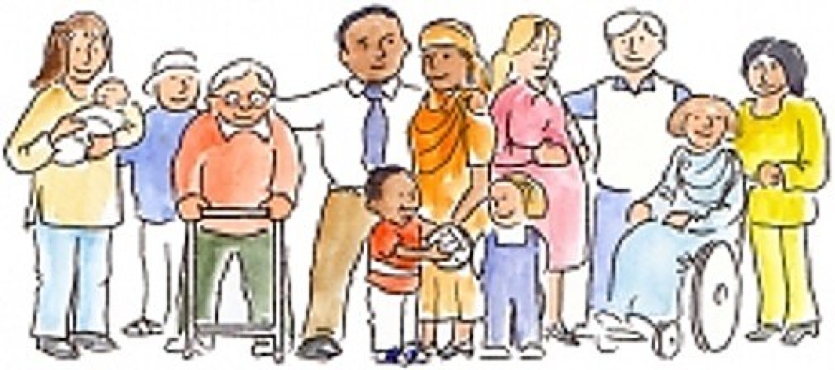Vulnerable Populations

- What are some of the determinants that make marginalized populations more at risk for chronic disease, substance use and mental illness?
- Socioeconomic status: Lower income linked to poor health outcomes, as well as linked to increase in obesity. Low income and low education level are associated with lower health status.
- Lower level of education in low and medium income countries have higher incidence of and mortality from cardiovascular disease (Rosengren et al, 2019).
- Access to healthcare: Importance of having access to health care and resources needed to sustain a healthy lifestyle, maintain prevention, and manage disease. Variable access to health care based on race, ethnicity, socioeconomic status, age, sexual orientation, disability status, gender identity, and residential location.

- How do Veterans, Homeless and Incarcerated populations intersect?

- Mental health/ substance abuse: Mental health related to trauma that can contribute to substance abuse, difficulty coping, and difficulty accessing healthcare.
- Limited access to care due to social exclusion: veterans, homeless, and incarcerated population at times might lack basic necessitates that prevents them from having access to health care.
- According to Watson in his article social exclusion, health and hidden homelessness (Watson et al, 2016) social exclusion refers to which individuals or groups are systemically marginalized or pushed to the fringes of society, limiting their access to resources, health care, opportunities, and therefore further limiting their participation in social, economic, political, and cultural life.
- Soft White Underbellies.
- The video I choice to review is Rachel, Registered nurse interview. Rachel started doing heroin in high school until about age 24, she eventually became a stripper to make money for drugs and to survive. She eventually went on to become an EMT and with getting help with her drug addiction with methadone. She went on to get her nursing license, and currently practices as a nurse. The moving parts of the video for me were how amazing and strong this individual is after all that she went through. She trusted herself and fought for what she wanted in life. It did make a difference for her to have a supportive person that was able to look up to and guided her through the addiction. She mentioned being on methadone and you can see how much that meant to her and that she was able to successfully complete the nursing program. It truly is rewarding watching these videos to see how important treatment is to people, and how much potential they have once they are in treatment.
- What action can we take to address the health disparities experienced by these groups?
As future health care providers there are several actions that we can take to address some of the disparities that veterans, homeless, and incarcerated populations face.
1. Better understand the challenges that certain circumstance pose for the vulnerable population.
a. Understand how to assess and what to look for in veterans (Johnson, et al 2013).
2. Identifying housing issues in our communities and the resources available for the homeless population. Better understanding the connection between housing and health disparities and the larger social issue that it has become (Stafford and Wood, 2017).
3. Improving continuation of health care for incarcerated populations post imprisonment. Providing and supporting post release services, suchs as case management, medication assistant treatments, and prescription support (Serafi et al, 2023).
Part B: Review of the following article:
https://pubmed.ncbi.nlm.nih.gov/34272857/
Several factors influence risk factors for veterans with substance use disorder (SUD) to have a reoccurrence, these factors include homelessness, unemployment, and insufficient SUD treatments. The findings in this study highlight the importance of tailored SUD treatments to veterans, the importance of completion, and resulting in lower substance use after the treatment (Betancourt et al, 2023).
References
Betancourt, C. A., Kitsantas, P., Goldberg, D. G., & Hawks, B. A. (2022). Substance Use Relapse Among Veterans at Termination of Treatment for Substance Use Disorders. Military medicine, 187(11-12), e1422–e1431. https://doi.org/10.1093/milmed/usab280
Johnson, B. S., Boudiab, L. D., Freundl, M., Anthony, M., Gmerek, G. B., & Carter, J. (2013). Enhancing veteran-centered care: a guide for nurses in non-VA settings. The American journal of nursing, 113(7), 24–40. https://doi.org/10.1097/01.NAJ.0000431913.50226.83
Rosengren, A., Smyth, A., Rangarajan, S., Ramasundarahettige, C., Bangdiwala, S. I., AlHabib, K. F., Avezum, A., Bengtsson Boström, K., Chifamba, J., Gulec, S., Gupta, R., Igumbor, E. U., Iqbal, R., Ismail, N., Joseph, P., Kaur, M., Khatib, R., Kruger, I. M., Lamelas, P., Lanas, F., … Yusuf, S. (2019). Socioeconomic status and risk of cardiovascular disease in 20 low-income, middle-income, and high-income countries: the Prospective Urban Rural Epidemiologic (PURE) study. The Lancet. Global health, 7(6), e748–e760. https://doi.org/10.1016/S2214-109X(19)30045-2
Serafi, K., Morgan, V. E., & Mann, C. (2023, April 25). States have new options to improve the health of people leaving jails and Prisons. New State Options Improve Health of People Leaving Jail Prison | Commonwealth Fund. https://www.commonwealthfund.org/blog/2023/states-have-new-options-improve-health-people-leaving-jails-and-prisons?utm_source=alert&utm_medium=email&utm_campaign=Achieving%2BUniversal%2BCoverage
Stafford, A., & Wood, L. (2017). Tackling Health Disparities for People Who Are Homeless? Start with Social Determinants. International journal of environmental research and public health, 14(12), 1535. https://doi.org/10.3390/ijerph14121535
Watson, J., Crawley, J., & Kane, D. (2016). Social exclusion, health and hidden homelessness. Public health, 139, 96–102. https://doi.org/10.1016/j.puhe.2016.05.017
Comments
Post a Comment